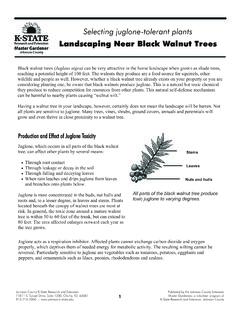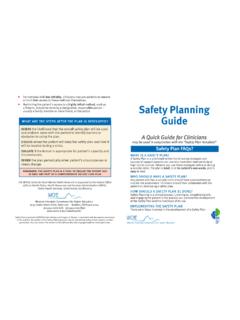Transcription of Identification and description - Research and Extension
1 Chapter 1. Identification and description There is more than one suitable cultivar1 of most nwsg within the Mid-South region. It is important to identify and determine the cultivar best suited for the intended use (whether wildlife habitat, livestock forage or both) and site conditions (such as bottomlands or dry uplands). Big bluestem Andropogon gerardii Big bluestem is a warm-season perennial that spreads by short rhizomes, creating clumps. Stems may reach 8 9. feet, depending on variety and site conditions. Growth begins in April; however, the majority of growth occurs after June 1. Growing points are close to the ground until late summer (after seedhead has formed) when they are 2 4 inches above ground. Leaves are long, flat and rough along the margins. The ligule is small and membranous;. the sheath is somewhat flattened, open and usually hairy.
2 One of the best features used to identify this grass before flowering is the presence of fine silky hairs on the sheath and widely dispersed on the upper leaf surface. The stem is usually purplish at the base and covered with fine hair. The seedhead is two or three distinct racemes on the top of the stem, resembling a turkey's foot. Awns make the seed appear 1. For clarification, a cultivar (or variety) is an ecotype that has gone through years of testing before release by a plant materials center. Cultivars are tested and selected for specific characteristics such as disease resistance, forage yield, or plant vigor. An ecotype is a selection of pre-varietal materials and differs Fig. The grand grass of the tallgrass prairie, big from other ecotypes in morphological and physiological traits, such as height, bluestem, was once quite prominent throughout stem diameter or growth rate.
3 A genotype refers to the hereditary make-up the Mid-South. and characteristics of a pure line (no genetic manipulation) or variety.. Fig. Andropogon gerardii Vitman Distribution by State USDA PLANTS Database Fig. Big bluestem can be identified fairly easily before flowering by the presence of small individual hairs at the base of the leaf. hairy. Big bluestem grows on a wide variety of soils, even on sites with a pH. as low as Big bluestem is extremely drought-tolerant, with root systems that may grow 12 feet deep. Cultivars of big bluestem adapted to the Mid-South Fig. Big bluestem seed region include: Rountree originally collected in Monona County (west central), Iowa and released for use in northern Missouri, Iowa and Illinois, this cultivar was developed for areas of the upper Midwest and eastern Rountree is well-adapted to the higher humidity levels of what once was the eastern tall grass prairie and prairie remnants of the north-eastern Rountree has a relatively short growing season, reaching maturity earlier than most varieties.
4 Niagara originally collected in Erie County, New York, this cultivar was released for its superiority over Midwestern cultivars in the northeastern It is adapted to various soil types, but grows best on moist, well-drained, fertile loam. Niagara is tolerant of hot, dry conditions, low-phosphorus soils and low pH. Root development may reach deeper than 10 feet. For these reasons, Niagara is suit- able for planting sand and gravel pits, strip mines and roadsides. Niagara has been grown successfully as far south as Tennessee, but is recommended from West Virginia to Maine.. Kaw originally collected along the Kaw River in eastern Kansas, Kaw thrives in hot, dry conditions, shows superior leafiness and vigor, and is considered more disease-resistant than some big bluestems. Kaw tends to develop rust in eastern, high-humidity regions.
5 It has a broader genetic base than Niagara or Rountree, thus Kaw matures over a longer period. Earl originally collected in Texas, this cultivar is adapted to all soil types in the South. Oz-70 originally collected in northern Arkansas and southern Mis- souri, this cultivar was released for its ability to grow in shallow, poorer soils. It has a very broad genetic base, including materi- als from all the regions where collected. Oz-70 is expected to do well in the southern Appalachians and have very good rust resistance in high-humid- ity regions. Fig. Schizachyrium scoparium (Michx.) Nash Distribution by State USDA PLANTS Database little bluestem Schizachyrium scoparium little bluestem is a warm-season perennial bunchgrass that grows 2 4 feet in height. Primary growth occurs from mid spring through summer, reaching maximum height in July.
6 Leaves are flat, often folded along the midrib, 6 10 inches long, less than -inch wide, and bluish-green through early summer until stems begin to form. The ligule is small and membranous, resembling a ring of short hairs on some plants; the sheath is flattened, open and may be purplish Charles Dixon at the base. The stem is flattened at base and often red or purplish during early growth. Mature plants are reddish- brown. The seedheads are racemes found singly, in pairs Fig. By mid-summer, little bluestem becomes or in groups and are produced in early fall. Awns make quite stemmy (if not previously hayed) and the the seed appear hairy. little bluestem grows on a wide red coloration begins to appear.. Fig. little bluestem seed variety of soils and is a very attractive grass in summer and fall. It has great potential for landscaping and erosion control on poor, droughty soils.
7 The cultivar best adapted and marketed for the Mid-South region is: Aldous originally collected from the Flint Hills of Kansas, this cultivar is leafy and late-maturing. Aldous produces better stands than other varieties and none are more adaptable or hardier. However, new cultivars are needed for the Mid- South region where high humidity and low soil pH can affect production of Aldous. Fig. little bluestem seedheads are Fig. This is a comparison not partly enclosed in a spathe as are of broomsedge (left) and broomsedge seedheads. little bluestem (right) in mid-October. The light tan color of broomsedge is most noticeable compared to the dark red stems of little bluestem. Color, however, may vary. Most important in distinguishing these species is the seedheads.. Fig. Andropogon virginicus L. Distribution by State USDA PLANTS Database Broomsedge bluestem Andropogon virginicus Broomsedge is a warm-season perennial bunchgrass that grows 2 4 feet in height.
8 Growth begins in spring when daytime temperatures reach 60 65 degrees F. Leaves are flat to partly folded (1/8 -inch wide) and may have sparse hairs at the leaf base on the upper side. The ligule is fringed and approximately 16-inch long; the sheath is flattened, overlapping at the base and usually pale yellowish-green. The stem is flattened at the base and smooth. Mature plants are tannish-brown. The seedheads are racemes partly enclosed in a large straw-colored spathe (reduced leaf or bract) as long as or longer than the raceme. little bluestem does not have this spathe (this is a definitive way to distinguish broomsedge from little bluestem after flowering). Mature broomsedge appears lighter in color than little bluestem, which usu- ally has a reddish hue. Also, the stem and leaves of little Fig. Broomsedge remains erect through winter bluestem often appear narrower than those of broomsedge.
9 Better than any other native warm-season grass. When dormant, broomsedge ap- pears quite orange-tan, while little bluestem is distinctly more red- dish-brown. Broomsedge grows on a wide variety of soils and is renowned for growing in old-fields low in fertility. Fig. Broomsedge bluestem seed . Fig. Indiangrass seed Fig. Sorghastrum nutans (L.) Nash Distribution by State USDA PLANTS Database Indiangrass Sorghastrum nutans Indiangrass is a warm-season perennial that spreads by Fig. The golden seedhead of indiangrass is seed and short rhizomes; however, it normally occurs in easily distinguishable and very attractive. bunches, much like big bluestem. Growth begins in April and, depending on site, will reach 3 7 feet in height. Leaves are flat and narrow at the base, growing 10 24 inches long. The ligule is quite prominent (up to inch long) and notched at the tip, making it resemble the rear sight on a rifle this is one of the best features used to identify indiangrass before flowering.
10 The sheath is round and open and is generally shorter than the internodes. The seedhead of indiangrass is a beautiful golden bronze-to-yellow, tight panicle 6 12 inches long, usually formed in August. Awns may be inch long, making indiangrass seed bearded and very fluffy. Indiangrass produces a deep root system, making this grass quite drought-tolerant. It is a heavy seed producer and one of the first perennial native grasses to re-colonize old-fields and disturbed soils if a seed source is nearby. Cultivars of indiangrass adapted to the Mid-South region include: Fig. Indiangrass has a very prominent ligule at the base of Osage originated from collections made in southeastern Kansas. It the leaf, unlike any other nwsg. is a vigorous, leafy cultivar, well-adapted to drier climates. Osage This is a very good identifying characteristic before flowering.




